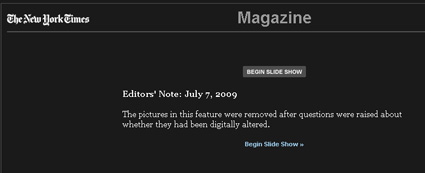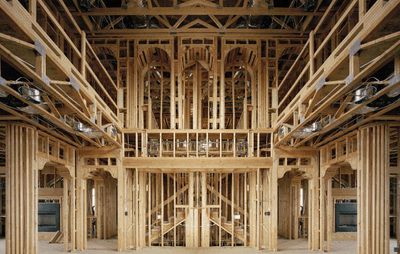
Whoops. It’s happened, again. A journalist /photographer working on behalf of the New York Times is suspected of faking a story. In this case, it’s photographs that appeared in the NY Times Magazine about abandoned construction projects.
A contributor to Metafilter figured out that the picture was doctored to make the unfinished room more dramatic than it apparently really was; that the photographer essentially “mirrored” the image.
The “proof” is posted here, the Metafilter poster says. (Note: The proof in the link above is not a before-and-after, it’s proof that splitting it in half and copying it to the “other side” creates the same picture as the one published as original.)
If it is a doctored image, why do photographers think they can get away with this sort of thing in the age of the Internet? There’s always someone “out there” to uncover it.
Someone like Adam Gurno of Northfield Rosemount. He’s the one who proved the image had been doctored.
“It was an excellent photo essay,” he told me this afternoon. “The picture of the framing is actually pretty striking. I looked at it and I said, ‘this doesn’t look right.'”
Gurno says he sent his proof to the Times but he only got a form e-mail in return. Nonetheless, the Times has removed the photo essay from its Web site.
How the ethical lapse came to light should be a warning to all journalists.
“When you work in computer programming…there’s a maxim in the programming world that says ‘all bugs are shallow to 10,000 eyes.’ It means if you have something open source and you let 10,000 people look at it, they’re going to find all the little things about it. Everybody’s going to approach it from a slightly different angle. And I think it’s the same with this picture,” he said.
“I understand magazines Photoshop models on their covers and that’s neither here nor there. But when they actually call it ‘journalism,’ that’s when I decided to dig in a little bit extra,” he said.
Here’s the full interview:
-
Audio not found
Update 3:57 p.m. – An excellent post on digital manipulation can be found here.
Update 4:59 p.m. – The New York Times will run the following correction in Thursday’s session:
A picture essay in The Times Magazine on Sunday and an expanded slide show on Nytimes.com entitled “Ruins of the Second Gilded Age” showed large housing construction projects across the United States that came to a halt, often half-finished, when the housing market collapsed. The introduction said that the photographer, a freelancer based in Bedford, England, “creates his images with long exposures but without digital manipulation.”
A reader, however, discovered on close examination that one of the pictures was digitally altered, apparently for esthetic reasons. Editors later confronted the photographer and determined that most of the images did not wholly reflect the reality they purported to show. Had the editors known that the photographs had been digitally manipulated, they would not have published the picture essay, which has been removed from Nytimes.com.
(h/t: Sam Choo, All Things Considered)

